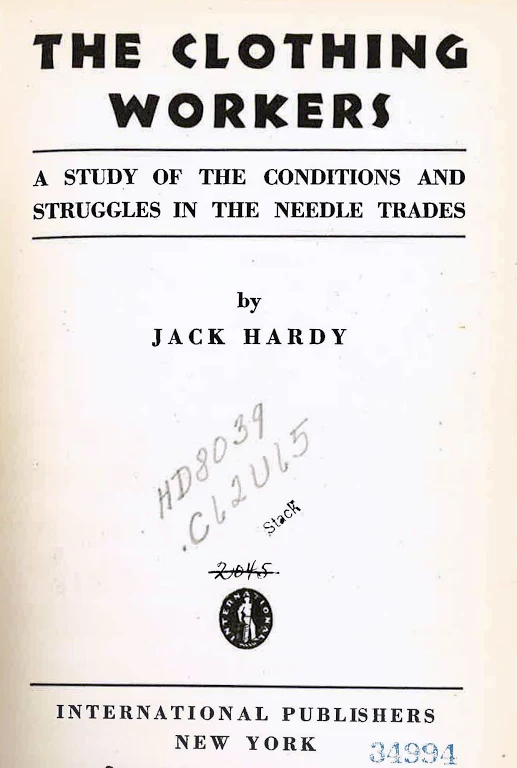
First Published: 1935.
Transcription, Editing and Markup: Paul Saba
Copyright: This work is in the Public Domain under the Creative Commons Common Deed. You can freely copy, distribute and display this work; as well as make derivative and commercial works. Please credit the Marxist Internet Archive as your source, include the url to this work, and note any of the transcribers, editors & proofreaders above.
CHAPTER I. WHO ARE THE CLOTHING WORKERS?
Skill, Women Workers, Child Labor, Young Workers, The Foreign-Born, Negro Workers
CHAPTER II. ORGANIZING THE WOMEN’S CLOTHING WORKERS
Earliest Beginnings, Rank and File Militancy, Birth of the International, The Uprising of the Twenty Thousand, The Great Revolt, Period of the Protocol, Rank and File Opposition, End of the Protocol, The Governor’s Commission, The Joint Action Committee, The ”Rotten Borough” System, The 1926 Cloak Strike, The Role of the International Officials, The 1926 Expulsions, The Struggle for Unity, 1927-29, National Organization Committee
CHAPTER III. LEFT WING UNIONISM AND THE RISING TIDE OF OPPOSITION
Needle Trades Workers Industrial Union, Industrial Union’s Record, Causes of Opposition Within the I.L.G.W.U., United Front Again Rejected, The I.L.G.W.U. Opposition, Strength of the Opposition, The International To-day, Role of the “Progressives,” The Industrial Union Offers Amalgamation
CHAPTER IV. ORGANIZATIONS AMONG THE MEN’S CLOTHING WORKERS
The Journeymen Tailors’ Union, The Cloth Hat and Cap Makers, The United Garment Workers, The Birth of the Amalgamated
CHAPTER V. DEVELOPMENT OF THE AMALGAMATED
Gathering Strength, The New York Lockouts, The Chicago Agreement, 1919, The International Tailoring Strike, 1925, Cross Currents, The Amalgamated in Business, The “New Unionism,” The Nash Agreement, Counter-Offensive, Smashing the Opposition, What Happened to Dissenters, Hillman Emerges Victorious, Demoralization and Disintegration, The Amalgamated and the NRA, No Readmittance into the A. F. of L., The Opposition Within
CHAPTER VI. FURRIERS’ ORGANIZATION
The International Fur Workers’ Union, Industrial Policies, Reaction and Revolt, The 1926 General Strike, A. F. of L. Interference, The A. F. of L. Again, The Mineola Trial, The Police-Bribe Investigation, The Woll-Mc-Grady “Reorganization,” The 1927 Strike, The Struggle for Unity, The Needle Trades Workers Industrial Union, Renewed A. F. of L. Activity, The N.T.W.I.U. and the Crisis, Victorious Advances, Counter-Offensive, The Industrial Union and the NRA, Recent Advances
Products of the Shops, Size and Number of Shops, The Jobber-Contractor System, Why Sub-Manufacturing Thrives, Where Clothing Is Made, Tendencies in the Industry, The Needle Trades and War, Concentration of Control
Wages during the crisis, Wage Cutting Methods, Payrolls and Workers’ Earnings, The Cost of Living, The NIRA, Hours, The Crisis and Working Hours, Hours in the NRA Codes, Actual Wages and Hours Under the NRA
CHAPTER IX. SPEEDING UP THE WORKERS
The Speed-Up, Standards of Production, Piece Work, Speed-Up as a Profession, Rationalizing Garment Production, High Speed Machinery, Effect on the Workers
CHAPTER X. UNEMPLOYMENT AND OCCUPATIONAL HAZARDS
Extent of Unemployment, How Jobs Are Lost, Diminishing “Seasons,” Need for Unemployment Insurance, Accidents, Occupational Diseases, Sanitation and Conditions of Work, Homework, The Return of the Sweat Shop
CHAPTER XI. EMPLOYERS’ ORGANIZATIONS AND TACTICS
The Bosses Unite, Local Associations, National and Regional Associations, Attitude Toward Labor, Individual Employers’ Activities, Other Gyp Schemes, The Government–Strikebreaker, When Employers Get Hurt, Prison Labor
CHAPTER XII. THE CLOTHING WORKERS’ PROGRAM